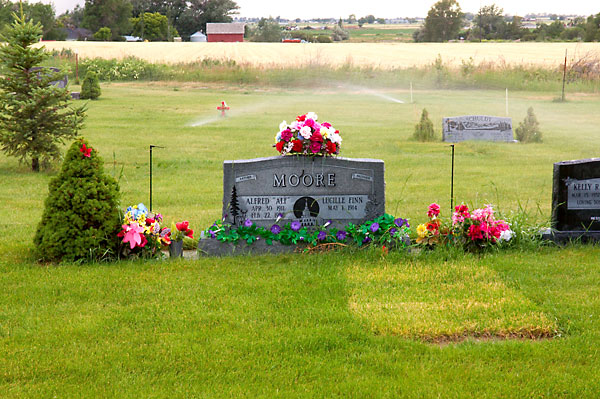 |
||
|
The Shelton Cemetery was once part of the Moore homestead
|
|||
|
In the foreground of this picture is the grave of Alfred (Alf) Moore who was a grandson of Willard Moore who married Annie
Morgan. Alfred was born 30 April 1911 and died 22 February 1999. The newly opened spot on the right side is the grave of his
wife, Lucille Finn Moore, who was born 1 May, 1914 and died 1 February 2004.
In the background of this picture can be seen part of the original Willard and Annie Moore homestead. The red barn is to the right of the original homestead house. The metal roof of the house can be seen just to the left of the barn, silo, and tree. The grainfield between the cemetery and the Moore farm still belongs to the Moore farm. And the picture makes it readily apparent where the Shelton Cemetery was taken out of the Moore farm. The high point on the East side of the Moore farm was donated for the cemetery. A HISTORY OF THE SHELTON CEMETERY A short history for the Shelton Cemetery. Willard Moore, a Shelton pioneer of 1890, donated an acre of his homestead for a community cemetery. The Moore's one-month-old son John is said to have been the first buried there, in May, 1891. State approval for cemetery sites was necessary; Shelton's hillside site met the requirements. An earlier Milo cemetery was disapproved, and graves from there were moved to Ucon, and to Shelton. Tombstones in Shelton showing pre-1891 dates are graves moved from elsewhere. A little later, cemetery committee members Edward (Ted) Morgan, John Johnson, E. H. Egan and David Ririe purchased more land and a water right. Lots were sold for five dollars apiece for funds to pay the Moore family for more land. Neighbors and Shelton Ward members shared in the upkeep. Shelton Ward purchased and installed a gate and a fence in 1899. In pioneer days, families and neighbors cared for the sick - doctors were out of reach. When there was a death, friends would prepare and dress the body for burial; this task usually fell to the Relief Society. Friends would "sit up" night and day in the home, to comfort the family and enable them to rest, while watching that nothing disturbed the corpse until burial. Bishop John Shelton Howard, a carpenter, built many of the coffins; his wife Sarah A. Howard would line them with whatever cloth she could find. Schoolmaster John Johnson used his fine penmanship skills to carve wooden grave markers - none of these appear to have endured. John Johnson also owned a beautiful buggy with a fringe on top which served as a hearse. For many years this cemetery was only a sagebrush section of land surrounded by a fence. It was a tradition for families to meet at the cemetery on Decoration Day to clean off the weeds. They brought lilacs and peonies and yellow roses, and sometimes crepe paper roses. As a public works program during the depression years of the early 1930's, the federal government hired local pick and shovel workers to lay water lines for a Ririe city water system. As an extension of this project, a well was dug and water lines were laid in the cemetery. Unfortunately the well did not furnish enough water. Nevertheless, community members planted grass and brought young trees from nearby canyons to plant around the edges, and trees and shrubs to plant among the graves. For a time a tractor was used to power a pump installed in the side-hill ditch. Residents remembered that by 1935 the cemetery was green and beautiful. Later, after sprinkler irrigation was invented, Earl Hunter ran his farm sprinkler lines through the cemetery until, in the late 1950's, the cemetery district purchased their own system. After cemetery districts were created by county governments, tax money was available for maintenance. Affairs are administered by a board elected by district residents. The Willard Moore family took care of the cemetery for many years. John Miller served well and faithfully for a long time. While Frank Ryset was sexton, his wife, Priscilla Morgan Ryset, carefully drew maps showing the family plots and graves. Frank Howard, a carpenter like his father, made many wooden boxes for holding the coffins. Among other sextons who served were Howard Egan, Parley Ririe, Doyle Skinner, Clarence Park, Bruce Cole, Alma Cleverly. In the 1980's Delbert and Colleen Lundquist became the cemetery caretakers. Recent improvements include chain link fences and a handsome Bitsoi metal sign, which designates the "Ririe-Shelton Cemetery," as it has come to be known. Sprinklers extend into into the new section on the west. Delbert Lundquist cleaned out the old well and installed a faucet so visitors may have fresh water to drink and for flowers. Buried in the cemetery are a number of men who lost their lives in the service of their country, for Ririe and surrounding communities have always furnished a full quota of patriots to fight for our freedoms when the need arose. The area has mourned other servicemen too, whose bodies could not be returned. More than 1500 people are buried in the cemetery. A project sponsored by Ririe First Ward and under the direction of Rebecca Freeman updated records of the people buried in the cemetery. Many previously unmarked and unknown graves were identified. Now the cemetery is one of the best and prettiest in the area, and one that the whole community can be proud of. |
|||
